#inuk woman
Text
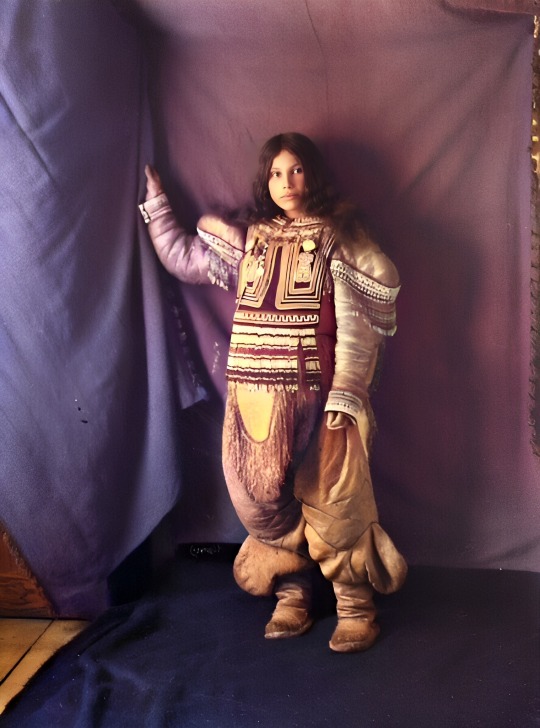


Portraits of Koo-tuck-tuck, an inuk woman by Geraldine Moodie, c. 1900s. Koo-tuck-tuck was deaf and dumb. The baby in the first picture was her son.
[colors by me]
92 notes
·
View notes
Text
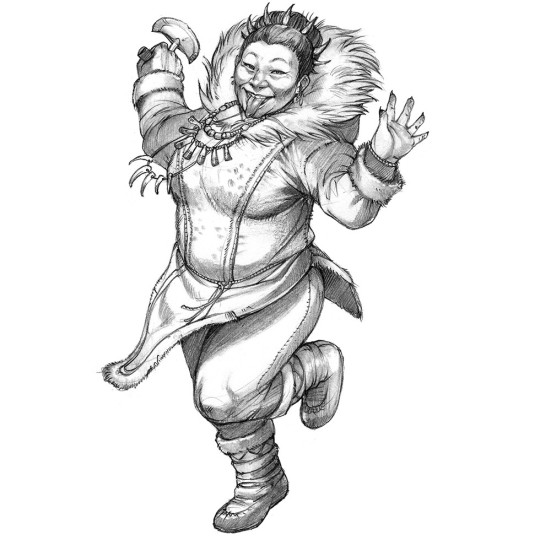
Aagjuuk the Entrail-Stealer [Inuit mythology]
In an earlier post, I talked about Taqqiq, the benevolent lunar spirit from native Inuit religion. Whenever a person dies, it is Taqqiq who guides them to the afterlife. Though he is a powerful and important spirit, he is not the sole inhabitant of the Earth’s moon. When Taqqiq is guiding a soul, they are greeted by Aagjuuk, also called Ululijarnaat or Aukjuk. This enigmatic spirit resembles an old woman and some versions claim that she is Taqqiq’s cousin. She always carries an ulu knife (a traditional Inuk tool for cutting ropes, hair etc.) and a copper pot.
Aagjuuk puts on a kind and friendly façade, but in reality she is a cruel and vicious monster. She will attempt to make the visitor laugh, but this is a test, and the soul must remain absolutely emotionless. If the victim so much as giggles, she will slice open their stomach with her ulu knife and then collect their innards with her copper pot. She then devours the victim’s entrails. Because of this, this spirit is fittingly called the ‘entrail-stealer’.
An Angakkuq (an Inuit shaman) could also converse with Aagjuuk through a special spirit-summoning ceremony, something like a séance. But this was a dangerous practise, for the entrail-stealer would then attempt to make the shaman laugh. If she succeeded, she would open the shaman and steal their entrails, just like she does with victims in the afterlife.
Oosten argues that it is also a symbolic thing: a hunter who does not manage to restrain or control himself will eventually become food for something else.
Sources:
Christopher, N., 2013, The Hidden: a compendium of arctic giants, dwarves, gnomes, trolls, faeries, and other strange beings from Inuit oral history, 191 pp, p. 178-183.
Oosten, J. G., 1981, The structure of the shamanistic complex among the Netsilik and Iglulik, Études/Inuit/Studies, 5(1): pp. 83-98.
Barraclough, E. R., Cudmore, D. M. and Donecker, S., 2016, Imagining the Supernatural North, University of Alberta, 328 pp.
(image source: Eva Widermann on Artstation)
48 notes
·
View notes
Note
Don’t forget, Sea Hawk is also apparently Asian. I also thought Frost might be Asian at first bc she kinda looks… maybe stereotypical isn’t the exact word, but just like what comes to mind when you think of a little Asian girl. Not to mention, she was originally designed as a white (Nordic coded?) teenager for this show before they decided to age her down into the little sister character. Never mind the fact the little sister character already existed in the old series with Glimmer and Allegra, and they could have done something with that, but I digress. I’ve also seen some people say Angella is Indian coded, because of the accent and her voice actress. Or maybe it’s because they think her gem is reminiscent of a bindi?
But yeah, idk about Perfuma, Entrapta, or Spinnerella. I think Perfuma could be latina because if the actress? But the character gives off the vibes of such a essential oils Karen that I associate with entitled white women, to the point I think she might just be a tanned white woman? Though I’ll admit, when I first saw her design I considered black and white biracial, and I considered Pacific Islander. So I have no idea. I’ve also seen some people interpret Entrapta as black. Though, I doubt it based on the hair alone. I like to think she’s latina, simply because I want her as my Latin rep, and not the literal cat. As for Spinnerella, I got nothing. Maybe white? All I know is that Huntara should have been black, and isn’t even coded as black. And I think that’s dumb, because I would have loved buff, queer, gets-a-character-arc Grace Jones in this show, since we didn’t get to have it in the old one.
Okay, hold on. I had no idea Sea Hawk was apparently half-Asian. I had to look this up. It was "confirmed" (as in, on Twitter) by the lead character designer for SPOP, who also "confirmed" Scorpia as half-Asian as well. However, I'm pretty sure Frosta is supposed to be Inuk like Katara, but I don't think that was ever confirmed. I could be wrong. I'm not even sure where her kingdom is located, for that matter. The worldbuilding in SPOP sucks so badly I barely remember how the kingdoms were like, save for Perfuma's and maybe Mermista's.
Idk, man. I honestly don't think that much about most characters' ethnicities, because the SPOP crew clearly didn't put a lot of thought into it. I mean, the literal cat teenager who licks herself, who walks on fours, who bites and claws people, who hisses and hates water, and who's sexualized on top of it all, is supposed to be Latina. Or Iranian or Middle Eastern, because apparently OG Catra came from "Purrsia", which is like... the Persian Empire? And fans really want to apply that to the reboot, too. Except Catra's origins were never brought up in SPOP, only that Catra was found abandoned in a cardboard box according to Nate. Regardless, neither theories are great because both Latinas and Iranian women (and Middle Eastern women in general) are not treated like people. They're sexualized and are victims of colonization. I've heard people headcanon Catra as Indigenous, too. Which is even worse considering she got her hair cut against her will.
As for the other characters... I just don't care, lmao. I will agree that Huntara should've been black, too. But since the SPOP crew didn't care about developing their kingdoms and their origins, then I don't think that hard. I mainly mention and dissect "Latina" Catra because the fandom won't shut up about her. Idk about Entrapta's ethnicity, but if Latina Entrapta makes you happy, go for it. Especially because Latin America is pretty diverse, so there are a lot of possibilities.
I don't agree with the term Karen, though. I get what you mean, that Perfuma is annoying and ableist and treats other people like garbage, but sadly that's another term that actual misogynists use against any women who get angry. But I know that's not your intention, I get where you come from.
#sorry this got long lmao#i'm just.#what the fuck i didn't even know sea hawk was half asian!!!!#and i'm not even happy about it i'm just angry that this is another thing they never expanded on#asks#spop critical#racism tw#long post
28 notes
·
View notes
Text
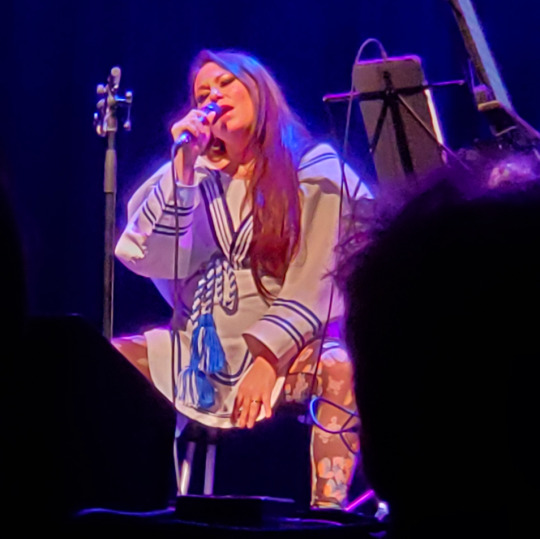
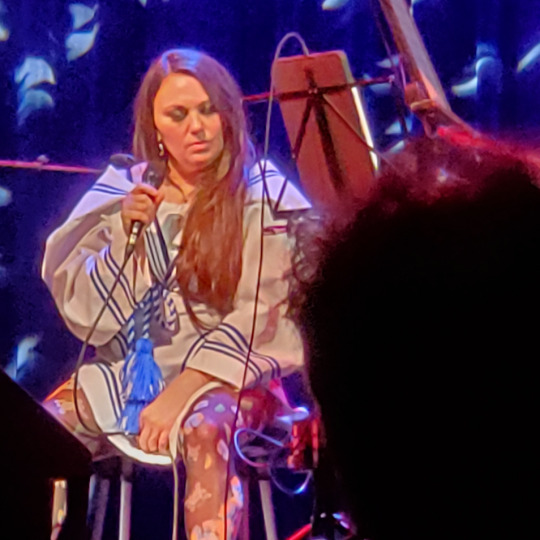


I really wish I could have gotten better photos of Tanya Tagaq performing with Kronos Quartet at the Knoxville Civic Center, but these grainy shots still do a good job of conveying the absolute raw power that comes out of this woman. It's one thing to hear her blend of traditional Inuk throat singing and modern Patton-esque stylings through recordings, but it's a whole other ballgame hearing it live right in front of you.
The final song she performed was a reconstruction of "Colonizer" from her album Tongues. "This song is called 'Colonizer' because, well...we were colonized", she quipped to an audience that unfortunately was mostly made of of white aging hipster types that probably only know about Inuit struggles as it's written on paper in yellowing history books. Maybe they got a little bit more of an education when she started screaming.
#tanya tagaq#kronos quartet#big ears#big ears 2024#experimental music#avant garde#neoclassical#reviews
42 notes
·
View notes
Note
So you already discussed your hc for Luffy's ethnicity but what about the rest of the crew?
great question, i’ve been pondering about this for a while, it’s just when i saw luffy, i just knew he was my pasifika cousin 😭 i have reference sheets w all their hcs i’m working on to post later but let me go ahead n lay out rq how i would imagine the strawhats! i try to be as canon compliant as possible when assigning them.
usopp - afro-caribbean, specifically jamaican 🇯🇲
luffy - indigenous on both sides. so afro native samoan-brazilian. i stand by that forever. polynesian luffy real 🇼🇸🇧🇷. malagasy too. historically malagasy people are austronesian relatives as well anyway (malayo-polynesian) 🇲🇬
nami - thai-swedish. she’s ethnically fully thai, but when bellmere found her and nojiko, she took them to her hometown in sweden to be raised. im a firm believer in southeast asian nami 🇹🇭🇸🇪
zoro - afro japanese-caribbean. been a blasian zoro truther since day one. so japanese and haitian 🇯🇵🇭🇹
robin - double native as well !! native costa rican, the bribri people, and indigenous to eastern russia, yupik. she’s a challenge to figure out but i just know this is a native woman. 🇨🇷🇷🇺
jimbei - melanesian cousin fijian-indian !!! 🇫🇯🇮🇳
franky - italian american. only fueled by how water 7 is allegedly based on venice 🇮🇹🇺🇸 but also consider panamanian franky …🇵🇦 exactly. so he’s either panamanian or italian american to me
brook - afro-austrian ethiopian. an ethnically east african black man from austria(i also get new orleanian from him IF he were american)🇪🇹🇦🇹
chopper - if he were a human, indigenous canadian first nation (inuk) absolutely 🇨🇦
vivi - nubian and sudanese vivi on top !!! 🇪🇬 🇸🇩
sanji - french ……… 🇫🇷
i have headcanons for ace, sabo, dadan and some other characters too but this post is getting really long. to be continued !
55 notes
·
View notes
Note
you cannot "headcanon" a CANON bisexual as a lesbian. it's bi erasure? why do u want to take away from canon bisexual representation? weirdo. do you think its okay to take all canon lesbians and call them bisexual?
but you can “headcanon” a CANON straight as a gay? isn’t that straight erasure? why would you want to take away from canon straight representation? weirdo. do you think it’s okay to take all canon straights and call them gay?
first off, i’ve always said i’d be cancelled so quick for not being politically correct and this may prove my point thanks babe x
secondly, when i referenced MY OWN DRAWING as “my favourite lesbian” that was a literal reblogged tag. take a joke and a nice deep breathe before your poor 14 year old sense of identity is damaged. i’m bisexual and happily so, i was thrilled at her canon identity as a bisexual woman especially as an inuk myself cause that dual representation is unheard of. if i was to believe in bi erasure i’d be a hypocrite but literally calm the fuck down. i’ve got multiple messages and inboxes about this now and i’m fed up.
#if you’ve got that much of a problem with me then turn off anonymous or dm me#im happy to admit mistakes made but this is out of proportion reaction to a harmless joke#the first part was satire if you cannot read the room#korra#legend of korra#bisexual
29 notes
·
View notes
Text
Iqaluit RCMP say they've charged three women with fraud over $5,000 for claiming Inuit status.
Twin sisters Amira and Nadya Gill, as well as the woman who claims to be their adoptive mother Karima Manji, face two charges each.
The allegations are that the women used their status "to defraud the Kakivak Association and Qikiqtani Inuit Association of funds that are only available to Inuit beneficiaries by obtaining grants and scholarships."
As first reported by Nunatsiaq News in March, the twins have claimed to be Inuit, though Nunavut Tunngavik Inc. (NTI) confirmed to CBC that neither they nor their adoptive mother had received funding from NTI. NTI is responsible for overseeing the enrolment of Inuit under the Nunavut Agreement.
NTI launched an investigation and said it removed them from its enrolment list, and RCMP confirmed at that point they had opened an investigation into the matter as well.
In a news release Thursday morning, Iqaluit RCMP said an investigation found that between October 2016 and September 2022, the women applied for and obtained Inuit beneficiary status for the Gill sisters as adopted Inuit children.
That appears to line up with dates from NTI, who said the sisters were added to the Inuit enrolment list in 2016 after Manji applied on their behalf. Manji had identified Kitty Noah, an Inuk woman, as the twins' birth mother, the organization said.
But Kitty's son, Noah Noah, has said Kitty isn't related to the twins.
25 notes
·
View notes
Photo
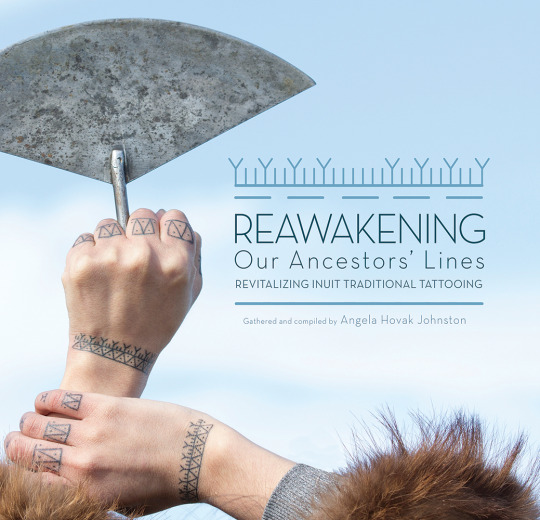


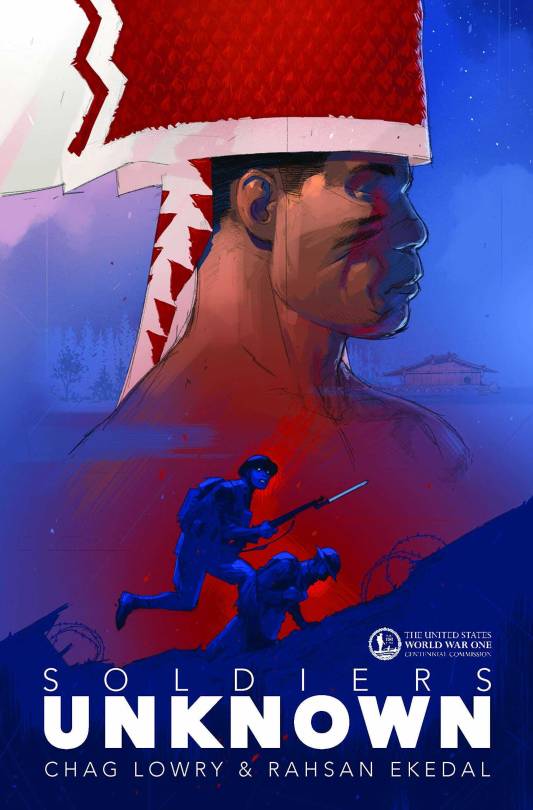


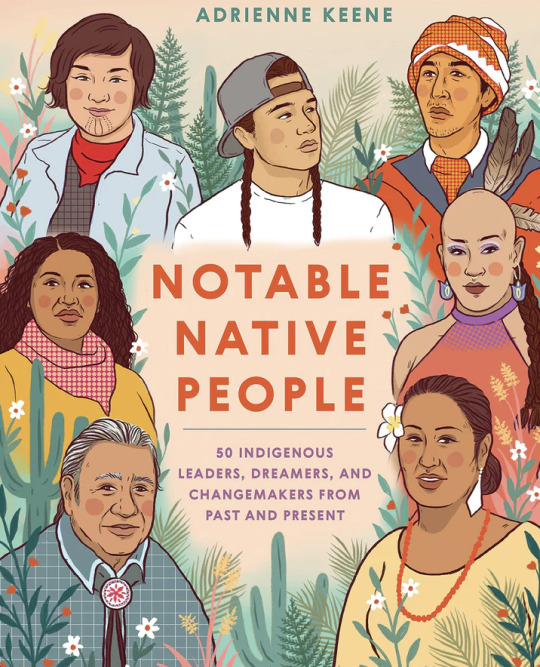


Reawakening Our Ancestor’s Lines and Other AIYLA Titles
When I was in the library the other day, a book cover caught my eye. Somehow I had missed out on this book that was released in 2017. I’m sure I saw the list when it was honored by The American Indian Library Association back in 2020, but I never got my hands on Reawakening Our Ancestors’ Lines: Revitalizing Inuit Traditional Tattooing until this week. It’s a gorgeous book that features Inuit women who are reviving the traditional art of tattooing. The author, Angela Hovak Johnston, learned how to tattoo herself and others and the book shares that journey with others.
For thousands of years, Inuit women practiced the traditional art of tattooing. Created with bone needles and caribou sinew soaked in seal oil or soot, these tattoos were an important tradition for many women, symbols stitched in their skin that connected them to their families and communities.But with the rise of missionaries and residential schools in the North, the tradition of tattooing was almost lost. In 2005, when Angela Hovak Johnston heard that the last Inuk woman tattooed in the traditional way had died, she set out to tattoo herself and learn how to tattoo others. What was at first a personal quest became a project to bring the art of traditional tattooing back to Inuit women across Nunavut, starting in the community of Kugluktuk. Collected in this beautiful book are moving photos and stories from more than two dozen women who participated in Johnston’s project. Together, these women are reawakening their ancestors’ lines and sharing this knowledge with future generations. [publisher summary]
This book is just one of the many that have won or been honored over the years. In case you’ve missed any of the titles, here are a few other YA books that have made the American Indian Youth Literature Award lists:
Apple Skin to the Core by Eric Gansworth (Onandoga)
The term “Apple” is a slur in Native communities across the country. It’s for someone supposedly “red on the outside, white on the inside.” Eric Gansworth is telling his story in Apple (Skin to the Core). The story of his family, of Onondaga among Tuscaroras, of Native folks everywhere. From the horrible legacy of the government boarding schools, to a boy watching his siblings leave and return and leave again, to a young man fighting to be an artist who balances multiple worlds. Eric shatters that slur and reclaims it in verse and prose and imagery that truly lives up to the word heartbreaking.
Firekeeper’s Daughter by Angeline Boulley (Sault Ste. Marie Tribe of Chippewa Indians)
As a biracial, unenrolled tribal member and the product of a scandal, Daunis Fontaine has never quite fit in—both in her hometown and on the nearby Ojibwe reservation. When her family is struck by tragedy, Daunis puts her dreams on hold to care for her fragile mother. The only bright spot is meeting Jamie, the charming new recruit on her brother’s hockey team.
After Daunis witnesses a shocking murder that thrusts her into a criminal investigation, she agrees to go undercover. But the deceptions—and deaths—keep piling up and soon the threat strikes too close to home. How far will she go to protect her community if it means tearing apart the only world she’s ever known?
Soldiers Unknown by Chag Lowry (Yurok, Maidu and Achumawi)
The graphic novel Soldiers Unknown is a historically accurate World War One story told from the perspective of Native Yurok soldiers. The novel is based on extensive military research and on oral interviews of family members of Yurok WW1 veterans from throughout Humboldt and Del Norte counties. The author Chag Lowry is of Yurok, Maidu, and Achumawi ancestry, and the illustrator Rahsan Ekedal was raised in southern Humboldt. Soldiers Unknown takes place during the battle of the Meuse-Argonne in France in 1918, which is the largest battle in American Army history.
Marrow Thieves and the sequel Hunting by Stars by Cherie Dimaline (Metis Nation of Ontario)
Marrow Thieves – Just when you think you have nothing left to lose, they come for your dreams.
Humanity has nearly destroyed its world through global warming, but now an even greater evil lurks. The Indigenous people of North America are being hunted and harvested for their bone marrow, which carries the key to recovering something the rest of the population has lost: the ability to dream. In this dark world, Frenchie and his companions struggle to survive as they make their way up north to the old lands. For now, survival means staying hidden – but what they don”t know is that one of them holds the secret to defeating the marrow thieves.
Notable Native People: 50 Indigenous Leaders, Dreamers, and Changemakers from Past and Present by Adrienne Keene (Cherokee Nation) and illustrated by Ciara Sana (Chamoru)
An accessible and educational illustrated book profiling 50 notable American Indian, Alaska Native, and Native Hawaiian people, from NBA star Kyrie Irving of the Standing Rock Lakota to Wilma Mankiller, the first female principal chief of the Cherokee Nation.
Celebrate the lives, stories, and contributions of Indigenous artists, activists, scientists, athletes, and other changemakers in this beautifully illustrated collection. From luminaries of the past, like nineteenth-century sculptor Edmonia Lewis--the first Black and Native American female artist to achieve international fame--to contemporary figures like linguist jessie little doe baird, who revived the Wampanoag language, Notable Native People highlights the vital impact Indigenous dreamers and leaders have made on the world.
Elatsoe by Darcie Little Badger (Lipan Apache Tribe)
Elatsoe—Ellie for short—lives in an alternate contemporary America shaped by the ancestral magics and knowledge of its Indigenous and immigrant groups. She can raise the spirits of dead animals—most importantly, her ghost dog Kirby. When her beloved cousin dies, all signs point to a car crash, but his ghost tells her otherwise: He was murdered. Who killed him and how did he die? With the help of her family, her best friend Jay, and the memory great, great, great, great, great, great grandmother, Elatsoe, must track down the killer and unravel the mystery of this creepy town and it’s dark past. But will the nefarious townsfolk and a mysterious Doctor stop her before she gets started? A breathtaking debut novel featuring an asexual, Apache teen protagonist, Elatsoe combines mystery, horror, noir, ancestral knowledge, haunting illustrations, fantasy elements, and is one of the most-talked about debuts of the year.
An Indigenous Peoples’ History of the United States for Young People adapted by Debbie Reese (Nambé Owingeh) and Jean Mendoza from the adult book by Roxanne Dunbar-Ortiz
Spanning more than 400 years, this classic bottom-up history examines the legacy of Indigenous peoples' resistance, resilience, and steadfast fight against imperialism.
Going beyond the story of America as a country "discovered" by a few brave men in the "New World," Indigenous human rights advocate Roxanne Dunbar-Ortiz reveals the roles that settler colonialism and policies of American Indian genocide played in forming our national identity.
The original academic text is fully adapted by renowned curriculum experts Debbie Reese and Jean Mendoza, for middle-grade and young adult readers to include discussion topics, archival images, original maps, recommendations for further reading, and other materials to encourage students, teachers, and general readers to think critically about their own place in history.
Surviving the City written by Tasha Spillet (Nehiyaw-Trinidadian) and illustrated by Natasha Donovan (Métis Nation of British Columbia)
Tasha Spillett's graphic novel debut, Surviving the City, is a story about womanhood, friendship, colonialism, and the anguish of a missing loved one. Miikwan and Dez are best friends. Miikwan is Anishinaabe; Dez is Inninew. Together, the teens navigate the challenges of growing up in an urban landscape - they're so close, they even completed their Berry Fast together. However, when Dez's grandmother becomes too sick, Dez is told she can't stay with her anymore. With the threat of a group home looming, Dez can't bring herself to go home and disappears. Miikwan is devastated, and the wound of her missing mother resurfaces. Will Dez's community find her before it's too late? Will Miikwan be able to cope if they don't?
To learn about even more books that have received this award, be sure to check out the AILA page.
162 notes
·
View notes
Text

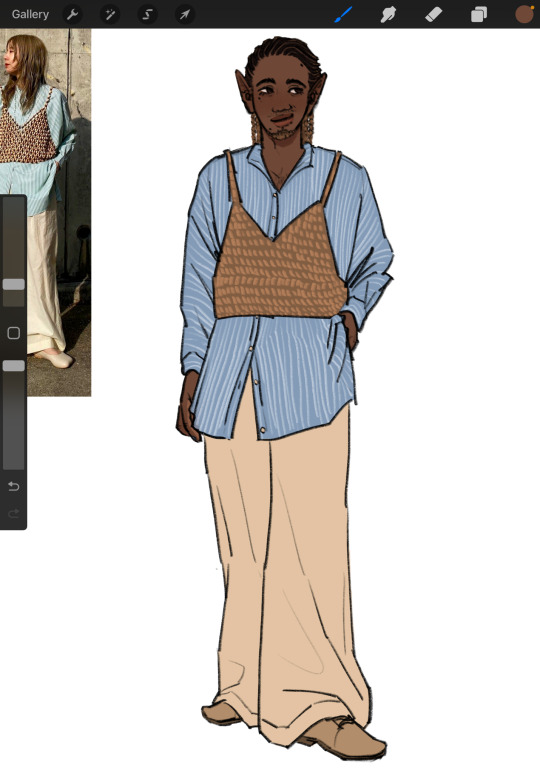
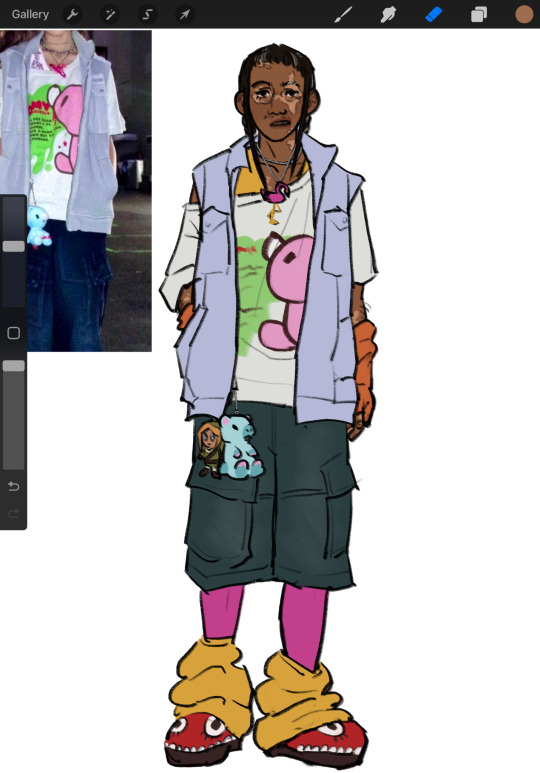



*throws some oc doodles at you* TAKE THESE
[ ID: six drawings of original characters. in order is jobie an inuk woman, elio a mixed black-italian man, salome a warao teen, rico a taíno man, pablo a chinese-polish person, and lae a khmer woman. they are all full body doodles screenshotted off procreate. END ID. ]
[ ID: six drawings of original characters. first is jobie, an inuk woman with brown skin, freckles, a unibrow and various scars on her right leg. she wears a green jacket, a white tshirt with a mountain range on it, a jean skirt, green sandals and socks and caribou fur earrings. second is is elio, a light skin mixed black and italian man with grown out bleached cornrows and facial hair, moles and pointed ears. he wears an untucked striped blue button up with a gold chained crop top, beige pants and beige dress shoes. third is salome, a warao teen with vitiligo, braids and little lip hair. he wears a yellow tank top, white graphic tee, a blue vest, orange arm warmers, jean shorts, pink tights, yellow leg warmers and red shoes with eyes and teeth. she has a blue bear plush and a link plush chained to her pants, and a flamingo necklace. fourth is rico, a taíno man with brown skin, shoulder length hair and moles. he wears a red and grey striped shirt, a green flannel tied around his waist, jeans, and brown shoes. fifth is pablo, a chinese-polish person with pale skin, eye bags, freckles, a cataract and scar over their eye. they have blue, pink and purple hair in two buns. they wear a yellow and brown collared shirt, a purple dress, a turquoise sweater, gold necklaces, pink tights, multicoloured socks and white shoes. sixth is lae, a khmer woman with brown skin, moles and acne. her bangs cover her eyes and she wears a black long sleeve with red scorpions, red pants with chains, black boots with spikes, and silver necklaces. END ID. ]
#more detailed ID under the cut !!#haiiiiii its been a while since i’ve posted my ocs#i figured it was time to give some of them attention again T.T#cause i miss and love them dearlyyy#just a bunch of warm up doodles tho ^.^#enjoy a rare pablo with their roots not grown out…#(i forgot about it until i posted but i mean. it technically does have to happen sometimes lol)#MWAH to jobie in specific love you always girlie#cutiest patootie#pmtOCs#jitters art#jobie kalvak#elio esposito#salome matarazzo teixeira#rico garcía de la cruz#pablo sokolowski#lae kham#ocs#original character
22 notes
·
View notes
Note
Isn’t snowbird also indigenous?
Oh god... So, that's not the easiest question to answer.
Snowbird's father was a white mortal man and her mother was "Nelvanna", an "Inuk goddess". Except as far as I'm aware at least, "Nelvanna" is completely made up and not at all actually derived from Inuk legends? At least, the only reference to a "Nelvanna" outside of Marvel is a very old comic book called "Nelvanna of the Northern Lights", which is probably where Byrne got his information from. So that's problem one: completely re-writing traditional Inuk beliefs.
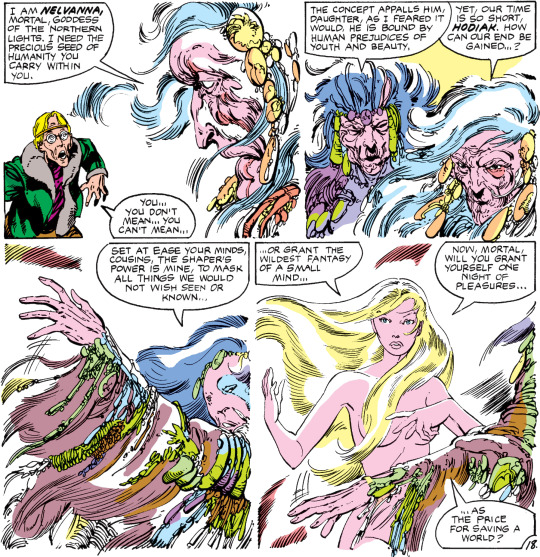
Snowbird's mother shapeshifted into a white woman in order to entice her father into sex. According to Snowbird, this is why she looks the ways he does, with blonde hair and pale skin.
So, this begs the question: Is Snowbird a whitepassing Indigenous woman, or is she just white? That's not so easy to judge.
I personally do not believe Byrne ever intended for her to be read as Indigenous, because it's very easy to compare her writing to how he wrote Michael and Elizabeth, and see the difference. That being said, in Marvel Age #2 he refers to her as a "half-breed", but it's possible he just meant her being half-goddess.
Most of her depictions, she is just a white woman. But Greg Pak once addressed her as "an inuit", in the same page he wrote her saying "all the coyotes I know are tricksters", despite there not being any coyote legends in traditional Inuk beliefs. That's about as Indigenous as she's gotten; some mixed up dialogue written as if all Indigenous legends are the same.
So, TL;DR: She is a very problematic character no matter how you swing at it. Either she's a terribly butchered depiction of an Indigenous character, or she's a walking symbol of cultural appropriation.
If it was up to me, I'd completely retcon her character and do some major rewriting. (You know, like I kinda did when making up an X-Men Evolution version of her.)
21 notes
·
View notes
Note
i know you said you think 90s aquaman would be executed differently today - do you mind explaining how? I'm curious about it (and reading thru that series atm :P)
Absolutely! While I do think 90s Aquaman is the best overall run, there are plenty of cringe-y things that could be improved upon. I think a lot of people forget the context of the time something is published (unfortunately, the 90s are actually several decades behind us) and while that doesn't excuse anything, it does open up potential to see things that don't age very well.
I think the overall treatment of Mera and Dolphin would have been better. Dolphin is so clearly written as a Love Interest First, Character Second that it puts her in an unfair light. Mera as well is hardly in the series, which I don't think DC would want these days. If it was written today, I think DC would have kept Mera around and had Dolphin be the Other Woman/Love Triangle aspect. I hate love triangles, so I don't think this would be an improvement per say, but it is what I think would happen. They would probably develop both women as being opposites of each other though, which could be fun.
Speaking of, I think they would have spent more time on the Garth/Dolphin romance. It's clearly a "we don't know how to use Dolphin now" moment because she was not very developed outside of Orin's storyline. I'm still down for a Dolphin/Garth romance, of course, because I think DC is still too cowardly to let him fuck a mermaid. Maybe in another 30 years? But with Dolphin as a developed character, the romance could happen over time instead of over a few issues.
I think Koryak and all the interactions with his people would be handled with a lot more research and grace. Admittedly, I have never heard an Inuk individual's stance on this comic (if you know of anyone, please link me!!), but reading those issues now...much improvement to be made, for sure. I would love to have Koryak really promoted as an Indigenous hero and that could happen if they had the right writers/researchers on the team. His powers are cool and honestly, I really like Koryak. This also applies to Orm, who is also an Inuk in the series. Although his purple Ocean Master outfit is my favorite, I total redesign could be cool. My hot take is that Orm is better when he's a jealous human. Not that New52 Orm is bad (it's the only character change I LIKE in the recent series) but there's something SO funny about Aquaman having super petty villians.
Vol 5 has a huge cast of really interesting characters, but not all of them got to shine. I think it's more likely that several of them would have gotten mini series or limited solos if it was made today. There's so much opportunity to lean into different mythology as well from around the world.
I think the lore of Atlantis overall would not need much changing (it's nothing like the current run, but in my perfect world where this is happening, the current run is wiped out and restarted lol) BUT if they wanted to loop in some characters who came from anything post-Flashpoint, I think a lot of them would fit very well into the storyline. The downside is that the writers would need to use their noodle and actually adapt the characters, and Aquaman writers are not allowed to do that. I think DC takes them out back and shoots them if they try. That's why none of our faves are in the comics :/
so tl:dr...more respect for the female characters, more respect and research into cultures used in the story, and better focus on some of the minor characters. If only...
8 notes
·
View notes
Note
if its alright to ask, whats your opinion on The Terror (the show)?
Hope you have a nice day, and feel free to ignore btw!
Okay this is going to be something i am even more insistent in making sure that this is my opinion only. I have never talked to another Inuk who watched the Terror other than my dad so i do not know what the general consensus is with Inuit fans.
To start off with the good: I enjoyed the show. It’s very well-written, and it never shies away from the fact that the men were colonizers that got what was coming for them (and no one lecture me on their “humanity” ill gut you like a fish). I enjoyed Silna’s place in the story, and though it is always going to be questionable to show white men enacting violence on an indigenous woman, this is definitely not the worst among them. I laughed really fucking hard when Goodsir was like “Englishmen are supposed to be gentlemen” or whatever and Silna gave him the meanest fucking look lol. I wish that I didn’t have to be glad that, at the very least, there’s no sexual assault but that’s how it is. I was incredibly impressed by the level of detail in portraying accurate clothing and dialect, and it made me incredibly happy to see it.
But just by the nature of the story the show is trying to tell, and more specifically the fact its an adaptation of a terrible book, it was never going to be even close to outstanding in my eyes. The main physical threat of the story aside from the white men themselves is a crude, fantastical interpretation of angakkuit helper spirits. It’s portrayed as savagely uncontrollable, and the fact that it was meant to protect the Inuit community that created it inadvertently portrays Inuit resistance as a horror. Basically every aspect of Inuit spirituality is portrayed as a horror, from the fake ritual including mutilation and the masked angakkuuk men, using us as scary props. Meanwhile, the Christianity in the show, even including the stark difference between Catholicism and Protestantism, is kept perfectly intact.
And, maybe more personal and feelings-driven than the rest of my issues, I simply could not connect with the white men than the person who recommended the show to me and the fandom as a whole. Even when I recognized the beautiful writing and characterization, every time I recognized the show was trying to make me care about them, I just remembered, these men hated my people more than they cared about survival. They were forces of violent colonialism, and their disappearance not only caused more violent racist white people to probe our land, us attempting to help them out killed us through diseases and ruined our oral histories’s credibility for CENTURIES. We were ridiculed by the British for telling the truth of their story, Charles Dickens famously called our stories “the chatter of a gross handful of uncivilized people”, and not only called us savages, but wrote a play portraying us as PART of the downfall of the expedition. Those stereotypes STILL persist today and, in a way, live on in the show. So, forgive me for not really caring if they wrote these men to be gay and multifaceted while the one indigenous woman was treated like shit.
Okay so um. That was long and I got heated. Despite my issues with the show, I would be lying if I said I did not enjoy the underlying story and revelled in their end. But the reasons I wrote above ultimately leave me in a place of “I wish this was about literally anything else,” so I could enjoy it without feeling gross.
#thank you for asking btw#I really like talking about this stuff but I worry I’m starting to come off as preachy for all these posts#asks#anon ask
5 notes
·
View notes
Note
Hi! I'm a Dominican/American woman that is incorporating different cultures into a fantasy story that I am currently writing. I want to incorporate Inuit culture into the story sometime within the later chapters, however, I do not want to disrespect or misinterpret any of the culture itself (I myself am a minority so I do understand how bad it is for your culture to be depicted in the wrong light). I hope I am not going against any boundaries, I love your blog! I was wondering if you can inform me about anything societal, culture, and physical about the Inuit culture. Like food, clothing, mythology, hairstyles, skin tones, etc. Along with any bad stereotypes associated with said culture (I know that the term Eskimo has a strange history but I will not be using that in the story to describe any inuk person). Also, is it disrespectful to give a female Inuk character of mine facial tattoos? Please let me know!
You should check my "eskimo on main" tag (which I'll put on this answer so it's just a click away) because i have covered every topic you mention to some degree.
Note that I am Inupiaq (a type of "inuk", tho i don't identify with that term, call me what i call myself because that's what i am, from northern and northwestern Alaska) and while "Inuit" is used to refer to a lot of different cultures, most use it to specifically mean those in Eastern Canada. I'm from a culture very geographically removed from what you may be expecting with a different history with other indigenous peoples and colonizers. For example, most Inupiat I know personally and have talked with online don't consider eskimo a slur and tend to be talked over by gussaks online who think they're more qualified to speak on the topic because they spent hours on twitter. I'm sure you've run into similar petty discourses in your time as a minority on the internet.
But yeah, read through the tag because i've written pretty extensively on topics like gender, sexuality, reincarnation and naming, spiritual beliefs, clothing, beauty, food, architecture, women's work, sports, marriage, the effects of colonization, Inupiaq Christianity, even the concepts of revenge and justice, and more. Sometimes in the form of quick, non-comprehensive cheat sheets, sometimes in essays with academic sources referenced. Read through it for like, a few days or a week, and get back to me if you still have unanswered questions. I'd love to help, but i may have already put months of effort into writing out exactly what you want to know and trying to just cough up a quick answer would be far less satisfactory for your curiosity and quest for knowledge.
32 notes
·
View notes
Text
there's this inuk woman name pauline who lives in my neighborhood who's friends with bella; she loves great danes and calls bella the queen of all dogs, a sentiment i of course wholeheartedly endorse
then yesterday she was walking down my street when bella was out front, so i came outside to try and get bella to be less loud in her excitement at seeing a friend, and pauline explained that she was on her way to make an offering over the water because her 38 year old pregnant daughter had just been killed
and the worst part is that i wasn't shocked. horrified, sick with anger and despair, but not shocked. because i know how this godforsaken settler colonial hellscape treats indigenous women, so it's not even a fucking surprise when they're murdered
but like i was fucked up about it yesterday then today i feel numb enough to talk about it, then tomorrow i just get to keep living my life. how the fuck is pauline supposed keep getting up in the morning for the rest of her life now
2 notes
·
View notes
Photo

Aasivak [Inuit mythology]
Given the harsh environment in which the Inuit people live, it comes as no surprise that Inuit mythology is full of stories about strange and dangerous monsters that dwell the snowy plains. Among them is Aasivak, the spider spirit. She is an Inua – a supernatural spirit – associated with spiders.
She wielded potent magical powers and was very skilled with them. Using her magic, she could shapeshift into different forms and transform into a human. It is said that Aasivak captured and ate humans.
One myth tells of an Inuk hunter who was searching for caribous. The man encountered a strange woman far away from his village. The woman invited him into her hut and he obliged. But when the hunter was inside her house, he could tell something was off. Although she looked human, she greatly terrified him for reasons that are unclear to me. Perhaps she exhibited some sort of magical power or perhaps she made a careless mistake when shapeshifting and retained some parts of her spider form. In any case, the frightened hunter attacked her and chopped off the creature’s head. The corpse fell on the ground and began to transform and shrink, until it became a spider. Terrified, the hunter ran away.
When he was outside, he looked back at the hut and could see Aasivak through the window. Somehow, she was a human again, and her head was attached to her body. Aasivak left her house and shouted at the hunter, asking him to come back.
The hunter, however, ran back to his village. This story originated in the Cumberland Sound area in Canada.
Source:
Christopher, N., 2013, The Hidden: a compendium of arctic giants, dwarves, gnomes, trolls, faeries, and other strange beings from Inuit oral history.
(image source: Germaine Arnaktauyok, illustration for “Those That Cause Fear” by Christopher Neil)
70 notes
·
View notes
Text
Celebrating International Women’s Day: Kenojuak Ashevak
Celebrating Inspirational Women, Happy International Women’s Day! March 8th.
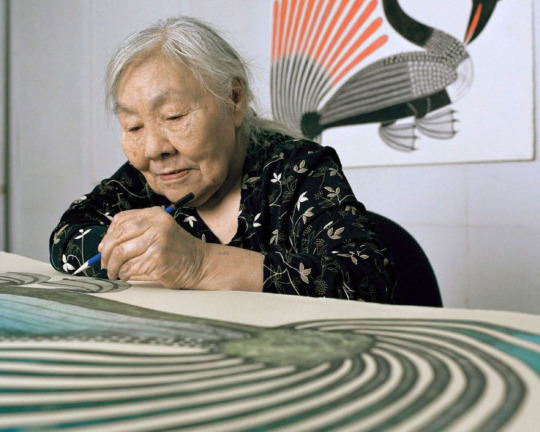
Born October 3, 1927 Baffin Island, died January 8, 2013
Kenojuak Ashevak was born in the outpost camp of Ikirasaq, to Silaqqi and Ushuakjuk, a hunter, fur trader and respected shaman.
She first learned traditional skills from her grandmother Koweesa, and began carving and drawing in her twenties alongside her husband Johnniebo Ashevak. (she had 11 children by her first husband and adopted five more). At the time of her death from lung cancer, she was living in a wood-frame house in Kinngait (Cape Dorset).
Kenojuak focuses on the process and aesthetics of drawing, she worked in carving and drawing but was noticed through her graphic work. Her work is characterized by a central element, an animal, bird, fish or human, position on the paper without the context of landscape or narrative devices. She created powerful and captivating images through subtle details. She was also the first woman to become involved with the newly established printmaking shop at Cape Dorset.
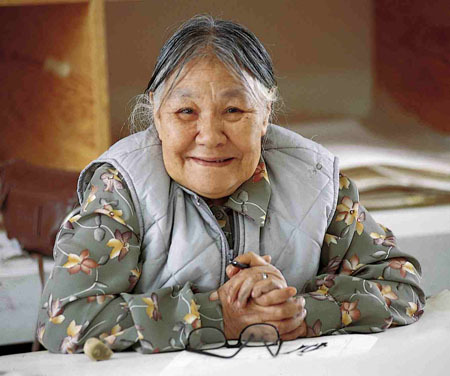
Kenojuak partricipated in exhibitions across Canada, Europe and Asia, her work is held in collections internationally. She had become a cultural ambassador and a role model for women.
The Enchanted Owl (1960) is one of her earliest and most well known pieces, which depicts an owl that faces out toward the viewer. The owl is significant to Inuit culture and spirituality. A source of guidance and wisdom, some Inuit believe that the owl safely shepherds the spirits of the dead to the afterworld.
In 1970, The Enchanted Owl was reproduced on a Canada Postage stamp, Kenojuak was the first Inuk to have her artwork on a stamp.
R. J. Davies
A Riveting Jacked-In Dreamy Mind-Bender
RJ Davies - Science Fiction Author, Maddox Files, Novels
#R. J. Davies#R. J. Davies Author#Rhonda Davies#Rhonda Davies Author#Rhonda Joan Davies#mystery author#science fiction author#Author of Maddox Files#Celebrating International Women's Day#International Women's Day#Kenojuak Ashevak
8 notes
·
View notes